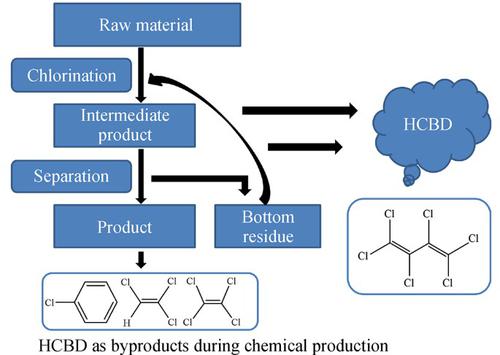Frontiers of Environmental Science & Engineering ( IF 6.4 ) Pub Date : 2020-10-11 , DOI: 10.1007/s11783-020-1352-8 Minxiang Wang , Lili Yang , Xiaoyun Liu , Zheng Wang , Guorui Liu , Minghui Zheng

|
Hexachlorobutadiene (HCBD) was classed as a persistent organic pollutant under the Stockholm Convention in 2015. HCBD is mainly an unintentionally produced by-product of chlorinated hydrocarbon (e.g., trichloroethylene and tetrachloroethylene) synthesis. Few studies of HCBD formation during chemical production processes have been performed, so HCBD emissions from these potentially important sources are not understood. In this study, HCBD concentrations in raw materials, intermediate products, products, and bottom residues from chemical plants producing chlorobenzene, trichloroethylene, and tetrachloroethylene were determined. The results indicated that HCBD is unintentionally produced at much higher concentrations in trichloroethylene and tetrachloroethylene plants than chlorobenzene plants. The sum of the HCBD concentrations in the samples from all of the trichloroethylene and tetrachloroethylene production stages in plant PC was 247000 µg/mL, about three orders of magnitude higher than the concentrations in the tetrachloroethylene production samples (plant PB) and about six orders of magnitude higher than the concentrations in the chlorobenzene production samples (plant PA). The HCBD concentrations were highest in bottom residues from all of the plants. The concentrations in the bottom residue samples contributed 24%–99% of the total HCBD formed in the chemical production plants. The bottom residue, being hazardous waste, could be disposed of by incineration. The HCBD concentrations were much higher in intermediate products than raw materials, indicating that HCBD formed during production of the intended chemicals. The results indicate the concentrations of HCBD unintentionally produced in typical chemical plants and will be useful in developing protocols for controlling HCBD emissions to meet the Stockholm Convention requirements.
中文翻译:

典型化工厂的六氯丁二烯排放量
六氯丁二烯(HCBD)在2015年被《斯德哥尔摩公约》列为持久性有机污染物。HCBD主要是无意生产的氯代烃(例如三氯乙烯和四氯乙烯)合成副产物。很少进行化学生产过程中六氯丁二烯形成的研究,因此人们不了解这些潜在重要来源的六氯丁二烯排放。在这项研究中,确定了生产氯苯,三氯乙烯和四氯乙烯的化工厂的原料,中间产品,产品和底部残留物中的六氯丁二烯浓度。结果表明,三氯乙烯和四氯乙烯工厂中无意生产的六氯丁二烯浓度比氯苯工厂高。工厂PC中所有三氯乙烯和四氯乙烯生产阶段的样品中HCBD浓度的总和为247000 µg / mL,比四氯乙烯生产样品(工厂PB)中的浓度高约三个数量级,而六氯乙烯的生产量中约六数量级高于氯苯生产样品(工厂PA)中的浓度。在所有植物的底部残留物中,六氯丁二烯的浓度最高。底部残留样品中的浓度占化工厂生产的六氯丁二烯总量的24%–99%。底部残留物为危险废物,可通过焚化处理。中间产品中六氯丁二烯的浓度比原材料高得多,这表明六氯丁二烯在生产预定化学品的过程中形成。



























 京公网安备 11010802027423号
京公网安备 11010802027423号